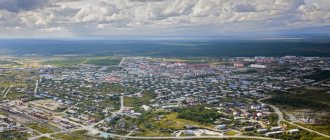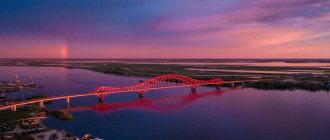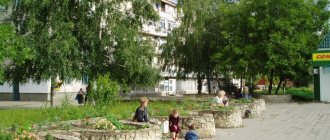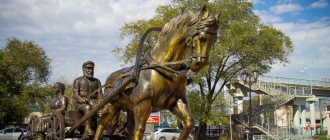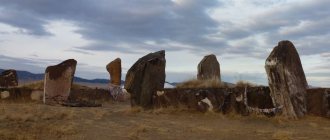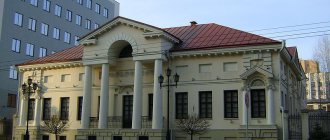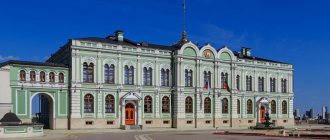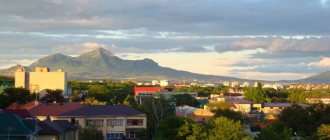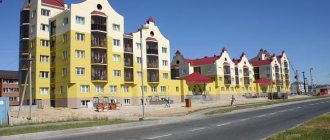Chronicles
Where is Tarko-Sale? In 1933, construction of a settlement began on the banks of the Pur River. At the same time, a small first-aid post with five beds was opened.
In 1934, a decision was made to create an inspectorate under the Purovsky District Executive Committee for the purpose of carrying out national economic accounting. In addition, the Rybkoopsoyuz was organized. One of the most important events was the organization of a regional radio communication center, after which radio points appeared in homes.
In 1935, the Department of Public Education was formed in the Purovsky district. There were seventeen students in the local school. Subsequently, the map of Tarko-Sale was replenished with a registry office, a people's court, a hospital, a fishing and reindeer herding collective farm, a veterinary station, a canteen, and a boarding school.
“Made with us” and on Yandex.Zen
Tarko-Sale is the youngest and at the same time one of the oldest cities in Yamal.
https://fotki.yandex.ru/users/lapshin-8975/view/505351/
The history of the city began on January 7, 1932, when by decree of the All-Russian Central Executive Committee the Purovsky district was formed as part of the Yamal (Nenets) national district with a temporary administrative center in the middle the flow of the Pur River. In those distant years, the middle course of the river was the most uninhabited part of the future region; the natural border of settlement of the tundra and forest Nenets passed there. In April of the same year, the so-called Purov expedition was formed, headed by the chairman of the organizing bureau for organizing the region, Georgy Ivanovich Onosov. The members of the expedition were faced with the following tasks: to get to the river before the beginning of the spring thaw. Pur and in the summer to complete the work on organizing the Purovsky district. But due to early spring, the expedition was postponed until navigation opened. And only at the beginning of September 1932, on a barge towed by the Anastas Mikoyan motor ship, the expedition reached the village of Khalmer-Sede (now Tazovsky). The further journey, already along the Pur River, was continued on a barge, which was towed by a boat from the Uralpushnina enterprise. Due to ignorance of the river's fairway, the caravan moved slowly and only during daylight hours. Winter found the district organizers in the area of the future Urengoy settlement. There, on the left bank of the river, the expedition members stopped for the winter. Subsequently, the trading post, and then the village of Urengoy, were built on the right, higher and more convenient bank.
Administration of the Purovsky district.
“Administration of the Purovsky district of Tarko-Sale” on Yandex.Photos
https://fotki.yandex.ru/users/lapshin-8975/view/505347/
"Administration of the Purovsky District."
on Yandex.Photos Fire station.
"Fire Department."
on Yandex.Photos Memorial complex.
"Memorial Complex."
on Yandex.Photos At the end of December 1932, part of the expedition on reindeer sleds continued its journey up the river and a few days later reached the confluence of the Pyaku-Pur and Aivasedo-Pur rivers. After examining the area, the right bank of the Pyaku-Pura was recognized as the highest and most convenient place for the construction of the future regional center. On one of the trees that grew here, Mikhail Sargin, a member of the organizing bureau for organizing the district, made a note and wrote “Build here.” At this legendary place there now stands the monument “Coming from the Horizon”. The name of the future regional center was suggested by the Nenets: “Talka salya” means “settlement at the confluence of rivers.”
Bank of Tarko-Sale.
“Bank of Tarko-Sale” on Yandex.Photos
“Coming from the horizon.”
"They came from the horizon." on Yandex.Photos
https://fotki.yandex.ru/users/lapshin-8975/view/510443/
Tax Inspectorate.
“Our tax office” on Yandex.Photos
ST. NICHOLAS TEMPLE
https://fotki.yandex.ru/users/lapshin-8975/view/510442/
"ST. NICHOL'S TEMPLE" on Yandex.Photos
"In festive decorations." on Yandex.Photos
“St. Nicholas Church. Tarko-Sale, Yamalo-Nenets Autonomous Okrug" on Yandex.Photos
https://fotki.yandex.ru/users/lapshin-8975/view/505349/
The wintering experience of 1933 convinced the expedition members that the future regional center should be located as close as possible to the place of compact residence of the indigenous people. In those years, only a few families of Forest Nenets lived in the Urengoy area, and two clans roamed in the immediate vicinity of Tarko-Sale - Pyak and Aivasedo. On May 7, 1933, at the fourth meeting of the organizing bureau, the final decision was made to begin the development of a new settlement at the confluence of the Pyaku-Pur and Aivasedo-Pur rivers. At the beginning of August 1933, the organizing bureau for organizing the region left the Urengoy winter quarters. And on August 6, 1933, the first meeting of the Purovsky District Executive Committee took place in Tarko-Sale, at which it was decided to quickly begin the construction of a trading post, houses to accommodate people and premises for the Purovsky District Executive Committee. It was planned to complete construction of the first house by September 5.
Technical supervision service of the Yamal-Nenets Autonomous Okrug.
"Technical Supervision Service of the Yamal-Nenets Autonomous Okrug."
on Yandex.Photos KSK "Geologist".
"KSK "Geologist."
on Yandex.Photos Office of NOVATEK - Tarkosaleneftegaz LLC.
"Office of NOVATEK - Tarkosaleneftegaz LLC."
on Yandex.Photos Tarkosali Second School.
“Tarkosalinskaya school is the second.”
on Yandex.Photos It should be noted that right up to the beginning of the Great Patriotic War, the issue of moving the regional center from Tarko-Sale to another, more convenient place was repeatedly raised. Of all the options, two were the most discussed. The first is the Kharampur trading post, where in those years the density of the indigenous population was the highest in the region. And the second is the Kamennaya Gora tract, located from Tarko-Sale forty kilometers downstream of the Pura. The advantage of this place was its safety during the spring flood. Preparatory construction work even began here, and the first construction site established in the Purovsky district was called Kamennaya Gora. But these plans were not destined to come true; the war interfered.
Winter is coming soon.
"Winter is coming soon."
on Yandex.Photos of the Baikal shopping center.
"etc.
BAIKAL" on Yandex.Photos of the MEGA shopping center
"SPRING CAME.
04/18/2010.” on Yandex.Photos Pharmacy management and pharmacy.
“Pharmacy management and pharmacy” on Yandex.Photos
City administration.
"City Administration."
on Yandex.Photos The administrative center of Tarko-Sale, in contrast to the cities formed in the region during the “oil boom” of the 60-80s (Noyabrsk, Muravlenko, Gubkinsky), changed slightly. From its foundation, the village developed chaotically, without centralized networks. All buildings were built in wood, as temporary ones.
Pension fund building.
"Pension fund building." on Yandex.Photos
"Fountain." on Yandex.Photos “My home.” on Yandex.Photos
“Fountain” on Yandex.Photos
In the fall of 1933, the problem of providing the population with food arose. In this regard, the question arose about the formation of a collective farm, which could allow planned and stable production of products in the conditions of the unpredictable northern nature. For many years, it was agriculture that served as the economic basis for the life of the village and the region as a whole, and the enterprises that were the “progenitors” of the Verkhne-Purovsky agricultural enterprise arose simultaneously with the settlement - these are fishing artels. Therefore, the history of Tarko-Sale is almost unthinkable without the history of this enterprise. The history of the Verkhne-Purovsky agricultural production complex began in 1935, when the Muzhevsky deer farm was formed in the Shuryshkarsky district, which in the 40s was transferred to the Purovsky district. Based on the decision of the Yamalo-Nenets regional executive committee, on January 1, 1945, the Verkhne-Purovsky state farm was formed. M.N. was appointed the first director of the state farm. Kolitupkov. In parallel, on the territory of the Purovsky district, two collective farms were formed from traveling trading posts and simple production partnerships: in 1937 - the collective farm named after. March 8, and in 1943 - the collective farm named after. Stalin, which were annexed to the state farm in 1961, forming a single reindeer herding state farm “Verkhne-Purovsky”.
"City autumn." on Yandex.Photoshttps://fotki.yandex.ru/users/lapshin-8975/view/505348/
https://fotki.yandex.ru/users/lapshin-8975/view/505350/
https://fotki.yandex.ru/users/lapshin-8975/view/505726/
In the 60-80s.
XX century Tarko-Sale becomes one of the two industrial centers of the region (the second is the village of Urengoy). This time can be called a period of rapid transition from a weak agricultural economy to the development of large industrial production. Geophysicists were the first to come to the Purov land. In the summer of 1961, a detachment of the Tazov seismic exploration party under the leadership of M.S. Sharafutdinova carried out river seismic survey work along the Pur River from the village. Samburg to the upper reaches of the Pyaku-Pur River. After the end of the summer field season, the detachment was left for the winter in Tarko-Sale, where an independent seismic exploration team was created on its basis. In 1964, the drilling site was relocated to Tarko-Sale from the Narykar oil exploration expedition under the leadership of drilling master Viktor Ivanovich Shestakov. On January 13, 1965, on the banks of the Pyaku-Pur River, on Purpeyskaya Square, a drilling team led by Viktor Ivanovich began drilling the first deep well in the Purovsky region. To further explore the territory of the region, on April 1, 1965, the Tarkosali oil exploration expedition was created, thanks to whose work such large fields as Komsomolskoye, Tarasovskoye, East-Tarkosalinskoye, and West-Tarkosalinskoye were subsequently discovered. It was during this period that Tarko-Sale began to develop as an industrial center. New fields are being discovered, a gas pipeline and the Surgut-Urengoy railway are being built. https://fotki.yandex.ru/users/lapshin-8975/view/510429/
https://fotki.yandex.ru/users/lapshin-8975/view/510430/
The city-forming industry is oil and gas production. Main enterprises: NOVATEK-PUROVSKY ZPK - the largest gas condensate processing plant in Russia; NOVATEK-Tarkosaleneftegaz is an oil and gas producing company.
Sargin embankment.
https://fotki.yandex.ru/users/lapshin-8975/view/510431/
https://fotki.yandex.ru/users/lapshin-8975/view/510432/
In 1976, Tarko-Sale began to belong to the category of working settlements. In 1977, it was gasified. The development of the oil and gas industry contributed to the favorable development of the village and an increase in population. In 1967, after the death of the great drilling master Andrei Fedorovich Tarasov, the Tarasovskoye field and one of the central streets of the city of Tarko-Sale were named after him.
https://fotki.yandex.ru/users/lapshin-8975/view/510433/
Cultural center.
https://fotki.yandex.ru/users/lapshin-8975/view/510434/
In 2004, Tarko-Sale was given the status of a city.
This was largely facilitated by the changes and improvements that took place in the late 90s; now more than 20 thousand people live in the city. In 2013, Tarko-Sale will celebrate its 80th anniversary. https://fotki.yandex.ru/users/lapshin-8975/view/510435/https://fotki.yandex.ru/users/lapshin-8975/view/510436/
https://fotki.yandex.ru/users/lapshin-8975/view/510437/
GeoPur Hotel.
https://fotki.yandex.ru/users/lapshin-8975/view/510438/
https://fotki.yandex.ru/users/lapshin-8975/view/510439/
Square near Tarkosaleneftegaz.
https://fotki.yandex.ru/users/lapshin-8975/view/510440/
https://fotki.yandex.ru/users/lapshin-8975/view/510441/
https://fotki.yandex.ru/users/lapshin-8975/view/510444/
https://fotki.yandex.ru/users/lapshin-8975/view/510445/
Old House of Culture.
https://fotki.yandex.ru/users/lapshin-8975/view/510446/
Military registration and enlistment office.
https://fotki.yandex.ru/users/lapshin-8975/view/510447/
School.
https://fotki.yandex.ru/users/lapshin-8975/view/510448/https://fotki.yandex.ru/users/lapshin-8975/view/510449/
Kindergarten.
https://fotki.yandex.ru/users/lapshin-8975/view/510450/
https://fotki.yandex.ru/users/lapshin-8975/view/510451/https://fotki.yandex.ru/users/lapshin-8975/view/510452/
https://fotki.yandex.ru/users/lapshin-8975/view/510455/
https://fotki.yandex.ru/users/lapshin-8975/view/510456/
https://fotki.yandex.ru/users/lapshin-8975/view/510457/https://fotki.yandex.ru/users/lapshin-8975/view/510458/
https://fotki.yandex.ru/users/lapshin-8975/view/510459/
Post-war period
In 1947, many learned about where Tarko-Sale was located, since a unique estate of the Verkhne-Purovsky reindeer herding state farm was organized on its territory. It is still popular among travelers exploring the vast expanses of the Russian Federation.
In 1948, construction of the Salekhard-Igarka railway section began. The builders were fully provided with food and materials by local enterprises. A little later, the district authorities carried out certification of the village population and formed five streets. All households were assigned numbers.
Hard times
In general, the fifties of the twentieth century were a difficult period in the formation of the city. The development of Tarko-Sale, and the whole country, in principle, at that time proceeded at a depressingly slow pace. The forces of Soviet citizens, including Purovites, were aimed at restoring the national economy as quickly as possible after the devastating hostilities. However, although life after World War II could not be called easy, there were still some positive moments in the history of the city. So, it was during this period that the authorities of Tarko-Sale began to think not only about how to put an extra ruble into the country’s piggy bank, but also how to improve the life of the local population and organize their leisure time. One of the most significant in this regard was the formation of the Purovsky District Industrial Plant, the functioning of which was aimed at meeting the urgent needs of the Tarkosalan residents. In addition, the district cultural and educational department began its activities. In 1951, a sports community called “Collective Farmer” was created on a voluntary basis.
This is how slowly, literally brick by brick, the social foundation of the city was laid.
An excerpt characterizing Tarko-Sale
“The highest wisdom and truth are like the purest moisture that we want to absorb into ourselves,” he said. – Can I receive this pure moisture into an unclean vessel and judge its purity? Only by internal purification of myself can I bring the perceived moisture to a certain purity. - Yes, yes, that's true! – Pierre said joyfully. – The highest wisdom is not based on reason alone, not on those secular sciences of physics, history, chemistry, etc., into which mental knowledge is divided. There is only one highest wisdom. The highest wisdom has one science - the science of everything, the science that explains the entire universe and the place of man in it. In order to embrace this science, it is necessary to purify and renew one’s inner man, and therefore, before knowing, one must believe and improve. And to achieve these goals, the light of God, called conscience, is embedded in our soul. “Yes, yes,” Pierre confirmed. – Look with spiritual eyes at your inner man and ask yourself if you are satisfied with yourself. What have you achieved with your mind alone? What are you? You are young, you are rich, you are smart, educated, my sir. What have you made of all these blessings given to you? Are you satisfied with yourself and your life? “No, I hate my life,” Pierre said, wincing. “You hate it, so change it, cleanse yourself, and as you cleanse yourself you will learn wisdom.” Look at your life, my lord. How did you spend it? In violent orgies and debauchery, receiving everything from society and giving nothing to it. You have received wealth. How did you use it? What have you done for your neighbor? Have you thought about the tens of thousands of your slaves, have you helped them physically and morally? No. You used their works to lead a dissolute life. That's what you did. Have you chosen a place of service where you can benefit your neighbor? No. You spent your life in idleness. Then you got married, my lord, took on the responsibility of leading a young woman, and what did you do? You did not help her, my sir, to find the path of truth, but plunged her into the abyss of lies and misfortune. A man insulted you and you killed him, and you say that you don't know God and that you hate your life. There is nothing fancy here, my sir! - After these words, the Mason, as if tired from a long conversation, again leaned his elbows on the back of the sofa and closed his eyes. Pierre looked at this stern, motionless, senile, almost dead face, and silently moved his lips. He wanted to say: yes, a vile, idle, depraved life - and did not dare to break the silence. The Mason cleared his throat hoarsely and senilely and called to the servant. - What about horses? – he asked, without looking at Pierre. “They brought the change,” answered the servant. -Aren't you going to rest? - No, they told me to lay it down. “Will he really leave and leave me alone, without finishing everything and without promising me help?” thought Pierre, standing up and lowering his head, occasionally glancing at the Freemason, and starting to walk around the room. “Yes, I didn’t think so, but I led a despicable, depraved life, but I didn’t love it and didn’t want it,” thought Pierre, “but this man knows the truth, and if he wanted, he could reveal it to me.” . Pierre wanted and did not dare to tell this to the Mason. The person passing by, having packed his things with the usual, old hands, buttoned up his sheepskin coat. Having finished these matters, he turned to Bezukhy and indifferently, in a polite tone, said to him: “Where do you want to go now, my sir?” “Me?... I’m going to St. Petersburg,” Pierre answered in a childish, hesitant voice. - Thank you. I agree with you on everything. But don't think I'm so stupid. I wished with all my soul to be what you would have me to be; but I never found help in anyone... However, I myself am primarily to blame for everything. Help me, teach me and maybe I will... - Pierre could not speak further; he sniffed and turned away. The Mason was silent for a long time, apparently thinking about something. “Help is given only from God,” he said, “but the measure of help that our order has the power to give, he will give to you, my lord.” You are going to St. Petersburg, tell this to Count Villarsky (he took out his wallet and wrote a few words on a large sheet of paper folded in four). Let me give you one piece of advice. Having arrived in the capital, devote the first time to solitude, discussing yourself, and do not take the old path of life. Then I wish you a happy journey, my lord,” he said, noticing that his servant had entered the room, “and success... The person passing was Osip Alekseevich Bazdeev, as Pierre learned from the caretaker’s book. Bazdeev was one of the most famous Freemasons and Martinists back in Novikov’s time. Long after his departure, Pierre, without going to bed and without asking for horses, walked around the station room, pondering his vicious past and, with the delight of renewal, imagining his blissful, impeccable and virtuous future, which seemed so easy to him. He was, it seemed to him, vicious only because he had somehow accidentally forgotten how good it was to be virtuous. There was no trace of the former doubts left in his soul. He firmly believed in the possibility of a brotherhood of men united for the purpose of supporting each other in the path of virtue, and this was how Freemasonry seemed to him. Arriving in St. Petersburg, Pierre did not notify anyone of his arrival, did not go anywhere, and began to spend whole days reading Thomas a à Kempis, a book that was delivered to him by an unknown person. Pierre understood one thing and one thing while reading this book; he understood the still unknown pleasure of believing in the possibility of achieving perfection and in the possibility of brotherly and active love between people, opened to him by Osip Alekseevich. A week after his arrival, the young Polish Count Villarsky, whom Pierre knew superficially from the St. Petersburg world, entered his room in the evening with the official and solemn air with which Dolokhov’s second entered his room and, closing the door behind him and making sure that there was no one in the room there was no one except Pierre, he turned to him: “I came to you with an order and a proposal, Count,” he told him without sitting down. – A person very highly placed in our brotherhood petitioned for you to be accepted into the brotherhood ahead of schedule, and invited me to be your guarantor. I consider it a sacred duty to fulfill the will of this person. Would you like to join the brotherhood of free stonemasons on my guarantee? The cold and stern tone of the man whom Pierre almost always saw at balls with an amiable smile, in the company of the most brilliant women, struck Pierre. “Yes, I wish,” said Pierre. Villarsky bowed his head. “One more question, Count,” he said, to which I ask you not as a future Freemason, but as an honest man (galant homme) to answer me with all sincerity: have you renounced your previous convictions, do you believe in God? Pierre thought about it. “Yes... yes, I believe in God,” he said. “In that case...” Villarsky began, but Pierre interrupted him. “Yes, I believe in God,” he said again. “In that case, we can go,” said Villarsky. - My carriage is at your service. Villarsky was silent the whole way. To Pierre's questions about what he needed to do and how to answer, Villarsky only said that brothers more worthy of him would test him, and that Pierre needed nothing more than to tell the truth. Having entered the gate of a large house where the lodge was located, and walking along a dark staircase, they entered a lighted, small hallway, where, without the help of a servant, they took off their fur coats. From the hall they went into another room. Some man in a strange attire appeared at the door. Villarsky, coming out to meet him, said something quietly to him in French and went to a small closet, in which Pierre noticed clothes he had never seen before. Taking a handkerchief from the closet, Villarsky placed it over Pierre's eyes and tied it in a knot from behind, painfully catching his hair in the knot. Then he bent him towards him, kissed him and, taking him by the hand, led him somewhere. Pierre was in pain from the hair being pulled in by the knot; he winced in pain and smiled from shame for something. His huge figure with his arms down, with a wrinkled and smiling face, moved with uncertain timid steps behind Villarsky. After walking him ten steps, Villarsky stopped. “No matter what happens to you,” he said, “you must endure everything with courage if you firmly decide to join our brotherhood.” (Pierre answered in the affirmative by bowing his head.) When you hear a knock on the door, you will untie your eyes,” Villarsky added; – I wish you courage and success. And, shaking Pierre’s hand, Villarsky left. Left alone, Pierre continued to smile the same way. Once or twice he shrugged his shoulders, raised his hand to the handkerchief, as if wanting to take it off, and lowered it again. The five minutes he spent with his eyes tied seemed like an hour. His hands were swollen, his legs were giving way; he thought he was tired. He experienced the most complex and varied feelings. He was afraid of what would happen to him, and even more afraid of not showing fear. He was curious to know what would happen to him, what would be revealed to him; but most of all he was joyful that the moment had come when he would finally embark on that path of renewal and actively virtuous life, which he had dreamed of since his meeting with Osip Alekseevich. Strong knocks were heard on the door. Pierre took off the bandage and looked around him. The room was black and dark: only in one place was a lamp burning, in something white. Pierre came closer and saw that the lamp stood on a black table, on which lay one open book. The book was the Gospel; that white thing in which the lamp was burning was a human skull with its holes and teeth. Having read the first words of the Gospel: “In the beginning was the word and the word was to God,” Pierre walked around the table and saw a large open box filled with something. It was a coffin with bones. He was not at all surprised by what he saw. Hoping to enter into a completely new life, completely different from the previous one, he expected everything extraordinary, even more extraordinary than what he saw. The skull, the coffin, the Gospel - it seemed to him that he expected all this, expected even more. Trying to evoke a feeling of tenderness in himself, he looked around him. “God, death, love, brotherhood of people,” he said to himself, associating with these words vague but joyful ideas of something. The door opened and someone entered.
Life is getting better
The main event of the 1950s, both on a city and national scale, was the decision to stop the construction of the railway on the Salekhard-Igarka section. At the same time, the “rolling” of thousands of human lives under the “piece of iron” stopped. The unfortunate citizens no longer perished in the vast expanses of the Gulag. The image of Tarko-Sale as a unique zone began to gradually fade in the minds of millions of Soviet citizens.
Honorary statuses
In 1976, Tarko-Sale became a workers' village. The decision to assign this status was made by the executive committee of the regional Council of Deputies of Tyumen. In March 2004, it became a city of regional significance. At the same time, the appearance of Tarko-Sale began to rapidly change for the better. Soon the city acquired its own official symbols - a coat of arms and a flag. The latter is a reflection of the historical, cultural, socio-economic and other local traditions of the municipality.
Climate
Tarko-Sale is located in a zone of sharply continental climate, the average temperature in January is −30, July is +16.7.
- Average annual air temperature - −5.3 °C
- Relative air humidity - 75.6%
- Average wind speed - 3.1 m/s
| Climate of Tarko-Sale | |||||||||||||
| Index | Jan. | Feb. | March | Apr. | May | June | July | Aug. | Sep. | Oct. | Nov. | Dec. | Year |
| Average temperature, °C | −25 | −22,3 | −14,1 | −8,7 | 1,4 | 11,3 | 16,7 | 12,8 | 5,5 | −3,8 | −16,5 | −22,1 | −5,3 |
| Source: [www.retscreen.net/ru/home.php NASA. RETScreen Database] | |||||||||||||
Economy
Everyone knows how rich Russia is in oil and gas. Tarko-Sale is a city on whose territory the largest plant in the Russian Federation specializing in processing gas condensate and an oil and gas production company are located.
Since 2005, NOVATEK-Purovsky Plant has been processing deethanized gas condensate. This is the first such enterprise in the field of processing natural reserves that has appeared in the post-Soviet space over the past fifteen years. In 2013, the third stage of the plant was launched, and already in January 2014, production capacity was expanded from five to eleven million tons per year. This was achieved thanks to the commissioning of two modern technological lines for stabilizing gas condensate. Their total area is three million tons per year.
Transport system
Where is Tarko-Sale? The city is located three and a half thousand kilometers from Moscow. This route can be covered by car (along the Surgut-Salekhard highway), by train (to the Purovsk railway station) or by plane (the airport is located on the territory of Tarko-Sale).
Currently, direct flights have been established with Novy Urengoy and Salekhard. On September 1, 2013, the grand opening of traffic on the new bridge across the river took place. Pyaku-Pur, connecting Tarko-Sale and Purovsk. The significant structure was erected in record time - in a year and five months instead of the planned three years.
Notes
- ↑ 123
www.gks.ru/free_doc/doc_2016/bul_dr/mun_obr2016.rar Population of the Russian Federation by municipalities as of January 1, 2016 - ↑ 12345678910
www.MojGorod.ru/janao/tarko-sale/index.html People's encyclopedia “My City”. Tarko-Sale - [demoscope.ru/weekly/ssp/rus79_reg2.php All-Union Population Census of 1979 The size of the urban population of the RSFSR, its territorial units, urban settlements and urban areas by gender.] (Russian). Demoscope Weekly. Retrieved September 25, 2013. [www.webcitation.org/6GDOjhZ5L Archived from the original on April 28, 2013].
- [demoscope.ru/weekly/ssp/rus89_reg2.php All-Union Population Census of 1989. Urban population]. [www.webcitation.org/617x0o0Pa Archived from the original on August 22, 2011].
- [www.perepis2002.ru/ct/doc/1_TOM_01_04.xls All-Russian Population Census 2002. Volume. 1, table 4. Population of Russia, federal districts, constituent entities of the Russian Federation, districts, urban settlements, rural settlements - regional centers and rural settlements with a population of 3 thousand or more]. [www.webcitation.org/65AdCU0q3 Archived from the original on February 3, 2012].
- [www.gks.ru/bgd/regl/B09_109/IssWWW.exe/Stg/d01/tabl-21-09.xls Number of permanent population of the Russian Federation by cities, urban-type settlements and districts as of January 1, 2009]. Retrieved January 2, 2014. [www.webcitation.org/6MJmu0z1u Archived from the original on January 2, 2014].
- [tumstat.gks.ru/wps/wcm/connect/rosstat_ts/tumstat/resources/22904e804154168ab3dff7367ccd0f13/part+1.rar All-Russian population census 2010. Population size and its distribution in the Tyumen region]. Retrieved May 10, 2014. [www.webcitation.org/6PTJWMhJj Archived from the original on May 10, 2014].
- [www.yamal-sport.ru/files/1d4f9e3ff43d1e215d63a2772ccf75c4.doc Population estimate at the beginning of 2011 for municipalities of the Yamalo-Nenets Autonomous Okrug]. Retrieved January 30, 2015. [www.webcitation.org/6VyBm6bvC Archived from the original on January 30, 2015].
- [www.gks.ru/free_doc/doc_2012/bul_dr/mun_obr2012.rar Population of the Russian Federation by municipalities. Table 35. Estimated resident population as of January 1, 2012]. Retrieved May 31, 2014. [www.webcitation.org/6PyOWbdMc Archived from the original on May 31, 2014].
- [www.gks.ru/free_doc/doc_2013/bul_dr/mun_obr2013.rar Population of the Russian Federation by municipalities as of January 1, 2013. - M.: Federal State Statistics Service Rosstat, 2013. - 528 p. (Table 33. Population of urban districts, municipal districts, urban and rural settlements, urban settlements, rural settlements)]. Retrieved November 16, 2013. [www.webcitation.org/6LAdCWSxH Archived from the original on November 16, 2013].
- [www.gks.ru/free_doc/doc_2014/bul_dr/mun_obr2014.rar Table 33. Population of the Russian Federation by municipalities as of January 1, 2014]. Retrieved August 2, 2014. [www.webcitation.org/6RWqP50QK Archived from the original on August 2, 2014].
- [www.gks.ru/free_doc/doc_2015/bul_dr/mun_obr2015.rar Population of the Russian Federation by municipalities as of January 1, 2015]. Retrieved August 6, 2015. [www.webcitation.org/6aaNzOlFO Archived from the original on August 6, 2015].
- taking into account the cities of Crimea
- [www.gks.ru/free_doc/doc_2016/bul_dr/mun_obr2016.rar Population of the Russian Federation by municipalities as of January 1, 2016. Table “31. Population of cities and towns by federal districts and constituent entities of the Russian Federation as of January 1, 2016.” RAR archive (1.0 MB)]
- [yamalstat.gks.ru/wps/wcm/connect/rosstat_ts/yamalstat/resources/593234804fe77fe9be05ffd8c740ec4f/8_POPULATION+BY+NATIONAL+AND+RUSSIAN+LANGUAGE+SW+MO.pdf VPN volume 4. Table 4. Population by nationality and Russian language proficiency in municipalities of the Yamalo-Nenets Autonomous Okrug].
- [www.sever-press.ru/all-news/51225-2013-09-02-03-36-48.html Traffic on a new bridge over the Pyaku-Pur river was opened in Tarko-Sale]
